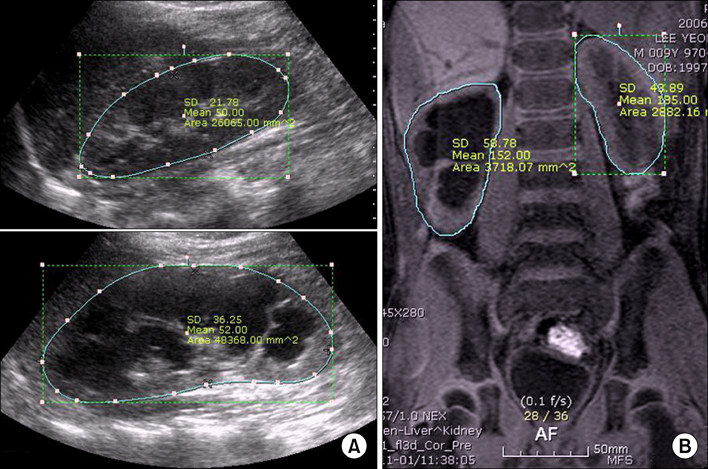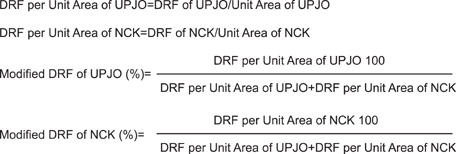Korean J Urol.
2010 Apr;51(4):271-275.
Modified Differential Renal Function Measurement Revised by Renal Cross Sectional Area in Children with Ureteropelvic Junction Obstruction
- Affiliations
-
- 1Department of Urology, Pusan National University School of Medicine, Pusan National University Yangsan Hospital, Yangsan, Korea. lsd@pusan.ac.kr
Abstract
- PURPOSE
Diuretic (99m)Tc-diethylenetriaminepentaacetic acid (Tc-DTPA) renal scans may show false-negative or false-positive results in children with ureteropelvic junction obstruction (UPJO). We evaluated whether modified differential renal function (DRF) revised by the renal cross-sectional area on imaging study may be a more valuable predictor than conventional DRF on a renal scan for deciding on a proper interventional time. MATERIALS AND METHODS: Between September 2001 and January 2008, we reviewed the diuretic renal scan results of 29 pediatric patients who underwent pyeloplasty due to unilateral UPJO. Diuretic renal scans using the standard (99m)Tc-DTPA protocol and imaging studies for renal unit measurement area were done. Conventional DRF measurement and modified calculation of DRF per unit area were done. Conventional DRF was classified into group I (below 40%) and group II (above 40%). RESULTS: The mean age of all patients was 42.6+/-52.6 months (range, 3-198 months). The mean cross-sectional areas of the UPJO kidney and of the normal contralateral kidney were 62.1+/-29.2 cm2 and 41.3+/-22.5 cm2, respectively (p<0.01). The conventional and modified DRF of the UPJO kidney were 45.2+/-9.2% and 35.2+/-9.5%, respectively (p<0.01). Thirteen children (62%) in group II (n=21) were classified in group I by the modified DRF measurement. CONCLUSIONS: The modified DRF measurement calculated according to cross-sectional area showed fewer false-negative results and may be a valuable method for deciding on pyeloplasty under equivocal circumstances.
Figure
Reference
-
1. Duckett JW Jr. When to operate on neonatal hydronephrosis. Urology. 1993. 42:617–619.2. Woodard JR. Hydronephrosis in the neonate. Urology. 1993. 42:620–621.3. Hyun IY, Lee DS, Lee KH, Chung JK, Lee MC, Koh CS, et al. Improvement of diagnostic accuracy by standardization in diuretic renal scan. Korean J Nucl Med. 1995. 29:497–503.4. Conway JJ. "Well-tempered" diuresis renography: its historical development, physiological and technical pitfalls, and standardized technique protocol. Semin Nucl Med. 1992. 22:74–84.5. Koff SA. Neonatal management of unilateral hydronephrosis. Role for delayed intervention. Urol Clin North Am. 1998. 25:181–186.6. Huang WY, Peters CA, Zurakowski D, Borer JG, Diamond DA, Bauer SB, et al. Renal biopsy in congenital ureteropelvic junction obstruction: evidence for parenchymal maldevelopment. Kidney Int. 2006. 69:137–143.7. Marra G, Barbieri G, Dell'Agnola CA, Caccamo ML, Castellani MR, Assael BM. Congenital renal damage associated with primary vesicoureteral reflux detected prenatally in male infants. J Pediatr. 1994. 124:726–730.8. Matsumoto F, Shimada K, Harada Y, Naitoh Y. Split renal function does not change after successful treatment in children with primary vesico-ureteric reflux. BJU Int. 2003. 92:1006–1008.9. Dubovsky EV, Russell CD. Advances in radionuclide evaluation of urinary tract obstruction. Abdom Imaging. 1998. 23:17–26.10. Choong KK, Gruenewald SM, Hodson EM, Antico VF, Farlow DC, Cohen RC. Volume expanded diuretic renography in the postnatal assessment of suspected uretero-pelvic junction obstruction. J Nucl Med. 1992. 33:2094–2098.11. Nam JK, Lee SD. Comparison of the effectiveness of the renogram, the serial renal scan and the diuretic half time according to the renal function for interpreting a diuretic DTPA scan following pyeloplasty. Korean J Urol. 2006. 47:402–406.12. Nguyen HT, Gluckman GR, Kogan BA. Changing the technique of background subtraction alters calculated renal function on pediatric mercaptoacetyltriglycine renography. J Urol. 1997. 158:1252–1256.13. Capolicchio G, Jednak R, Dinh L, Salle JL, Brzezinski A, Houle AM. Supranormal renographic differential renal function in congenital hydronephrosis: fact, not artifact. J Urol. 1999. 161:1290–1294.14. Ham WS, Jeong HJ, Han SW. Compensatory glomerular hypertrophy is not a cause of supranormal renographic differential renal function in patients with ureteropelvic junction obstruction. Korean J Urol. 2003. 44:34–39.15. Feder MT, Blitstein J, Mason B, Hoenig DM. Predicting differential renal function using computerized tomography measurements of renal parenchymal area. J Urol. 2008. 180:2110–2115.16. Kim YS, Cho CK, Han SW. Comparison between unilateral pyeloplasty and conservative treatment in bilateral ureteropelvic junction obstruction of children. Korean J Urol. 1998. 39:1248–1253.17. Homsy YL, Saad F, Laberge I, Williot P, Pison C. Transitional hydronephrosis of the newborn and infant. J Urol. 1990. 140:579–583.18. Homsy YL, Koff SA. King LR, editor. Problems in the diagnosis of obstruction in the neonate. Urologic surgery in neonates and young infants. 1988. 1st ed. Philadelphia: Saunders;77–94.19. Koff SA, Campbell K. Nonoperative management of unilateral neonatal hydronephrosis. J Urol. 1992. 148:525–531.20. Koff SA, Campbell KD. The nonoperative management of unilateral neonatal hydronephrosis: natural history of poorly functioning kidneys. J Urol. 1994. 152:593–595.21. Allen TD. The swing of the pendulum. J Urol. 1992. 148:534–535.22. Dhillon HK. Prenatally diagnosed hydronephrosis: the Great Ormond Street experience. Br J Urol. 1998. 81:suppl 2. 39–44.23. Han SW, Lee SE, Kim JH, Jeong HJ, Rha KH, Choi SK. Does delayed operation for pediatric ureteropelvic junction obstruction cause histopathological changes? J Urol. 1998. 160:984–988.24. Park S, Ji YH, Park YS, Kim KS. Change of hydronephrosis after pyeloplasty in children with unilateral ureteropelvic junction obstruction. Korean J Urol. 2005. 46:586–592.
- Full Text Links
- Actions
-
Cited
- CITED
-
- Close
- Share
- Similar articles
-
- Endopyelotomy as a Treatment for Ureteropelvic Junction Obstruction: 3 Cases
- Obstruction of the Ureteropelvic Junction in Children: Functional Evaluation of the Obstructed Kidney Postoperatively Using the 99mTc-DMSA Renal Scan
- The Investigation of Split Renal Function after Pyeloplasty Using 99m-Tc-DMSA Renal Uptake Rate in Children with Unilateral Ureteropelvic Junction Obstruction
- A Case of Renal Artery Stenosis Combined with Ureteropelvic Junction Obstruction in A Child
- Surgical Management of Ureteropelvic Junction Obstruction in Children



